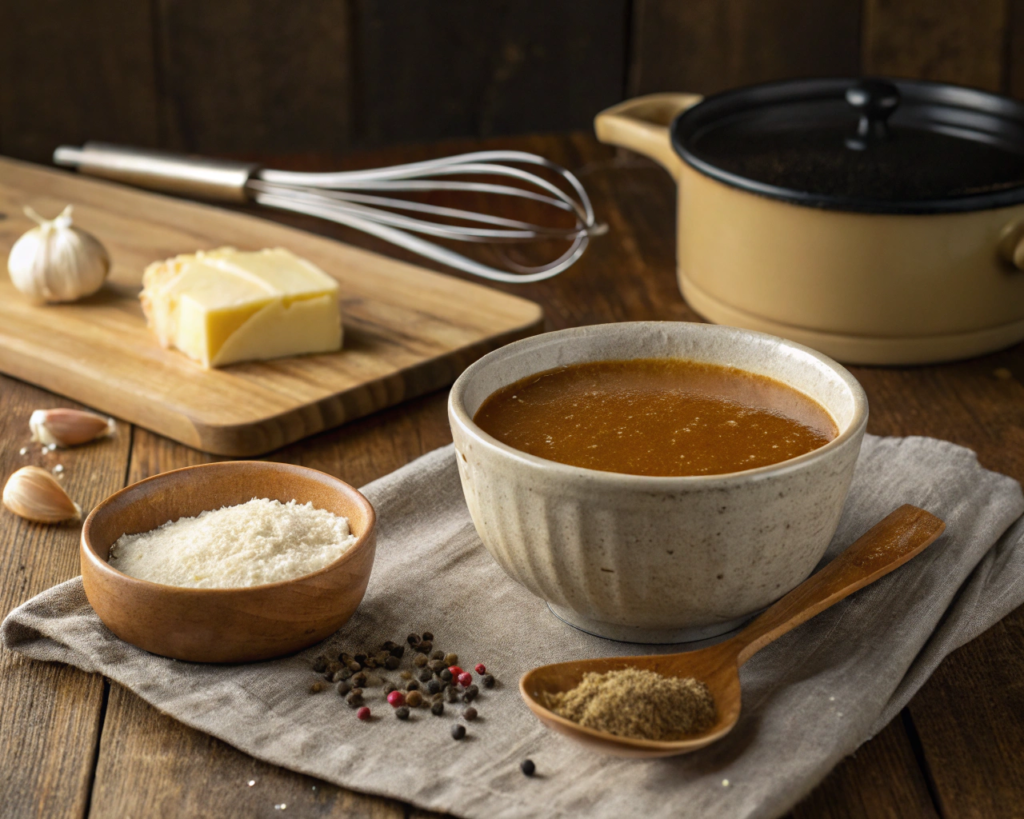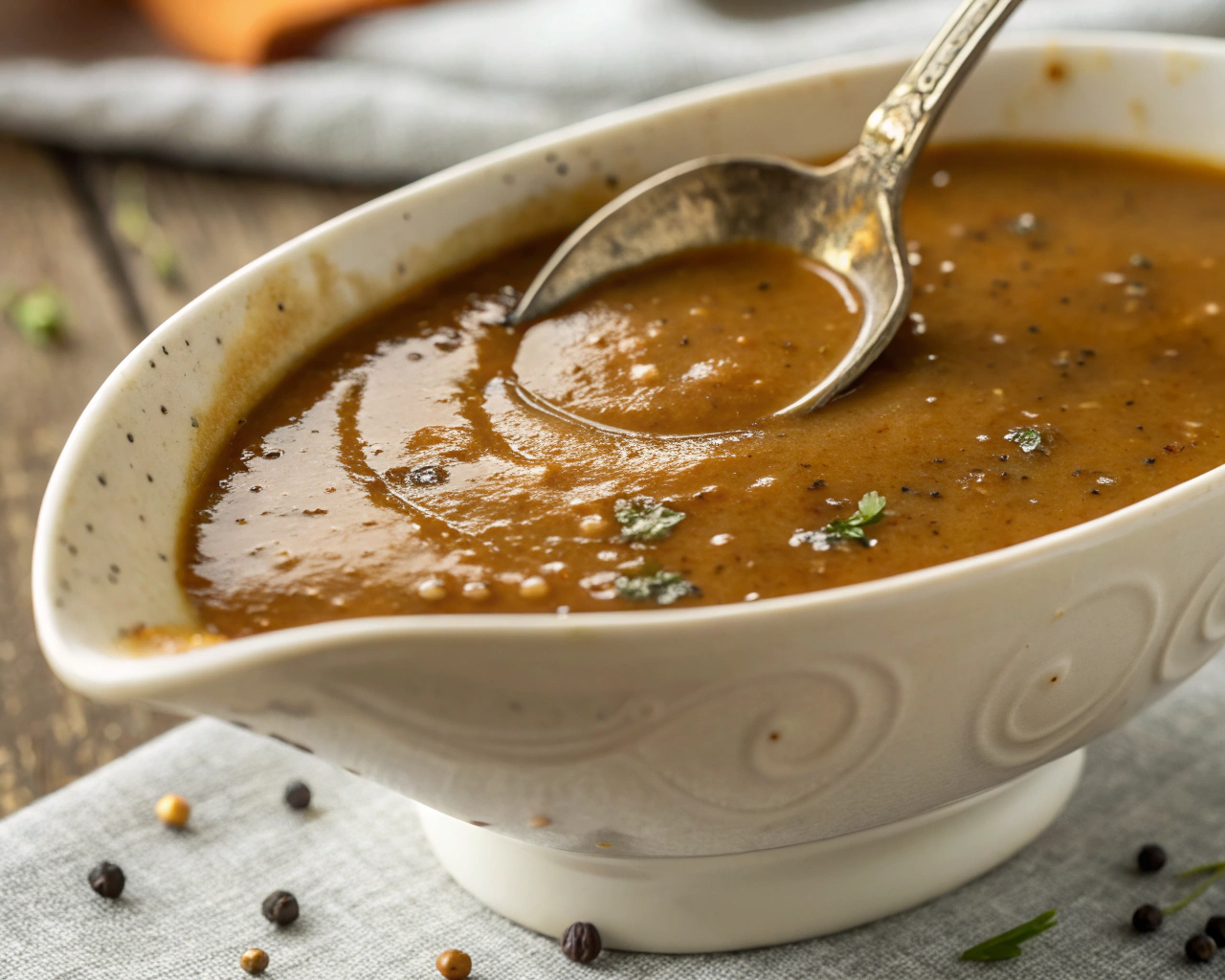Introduction
Nothing elevates a meal quite like a rich, flavorful homemade gravy. Whether served over mashed potatoes, roasted meats, or biscuits, gravy is the perfect finishing touch to many comfort foods.
Unlike store-bought versions filled with preservatives, making gravy from scratch allows you to control flavor, consistency, and ingredients. Plus, it’s quick and easy—requiring only a few pantry staples like butter, flour, and broth.
If you’re a fan of creamy dips, you might also love Crab Rangoon Dip, which shares similar thickening techniques with gravy!
Table of Contents
The Basic Ingredients for Homemade Gravy

1. The Three Essential Components
- Fat – Butter, pan drippings, or oil create a rich base.
- Thickener – Flour or cornstarch thickens the liquid.
- Liquid Base – Stock, broth, milk, or water enhances flavor.
Using high-quality stock is crucial for deep, savory notes. Check out this homemade stock guide to learn how to make the best broth for gravy.
2. Choosing the Right Ingredients
- Pan Drippings vs. Stock Cubes – Drippings give a meatier, richer taste, while stock cubes work as a substitute.
- Flour vs. Cornstarch – Flour creates a thicker, more traditional texture, while cornstarch yields a gluten-free, glossy finish.
- Butter vs. Oil – Butter adds richness, but oil works if you need a dairy-free option.
For more texture-related tips, read How Do You Keep Pound Cake Moist?—many of these principles apply to sauces too!
Step-by-Step Guide to Making Gravy from Scratch
1. Preparing the Ingredients
- Collect pan drippings (if available) or use butter.
- Heat stock or broth on the stove.
2. Making the Roux
- Melt butter in a pan over medium heat.
- Whisk in flour, stirring constantly until golden brown.
- Let it cook for 2-3 minutes to eliminate the raw taste.
3. Adding the Liquid
- Slowly pour in warm stock or broth while whisking continuously.
- Allow the mixture to thicken over low heat for 5-7 minutes.
- Season with salt, pepper, and optional herbs.
Want to master the perfect roux? Check out this detailed roux-making guide.
Types of Gravy and Variations
1. Brown Gravy
- Made with beef, pork, or chicken drippings and flour-based roux.
2. White Gravy (Country Gravy)
- Uses milk instead of broth, giving it a creamy texture.
3. Turkey Gravy
- Made with turkey drippings and herbs—a Thanksgiving staple.
4. Gluten-Free and Vegan Gravy
- Thickened with cornstarch instead of flour.
- Uses vegetable broth and olive oil for plant-based diets.
For another hearty comfort food, check out What Are Beef Nachos Made Of?—perfect for serving with gravy!
How to Fix Common Gravy Mistakes
1. Lumpy Gravy
- Strain through a fine-mesh sieve or blend until smooth.
2. Too Thin or Too Thick
- If too thin, add a cornstarch slurry (1 tbsp cornstarch + 2 tbsp water).
- If too thick, add warm broth gradually while stirring.
3. Gravy Lacks Flavor
- Boost taste with soy sauce, Worcestershire sauce, or herbs.
Check out this gravy troubleshooting guide for more solutions!
Best Foods to Serve with Homemade Gravy
Homemade gravy is a versatile and delicious addition to countless dishes, adding richness and flavor to both classic comfort foods and creative culinary creations. Here are some of the best foods to serve with homemade gravy:
Roasted Meats – Turkey, Chicken, Beef
Gravy and roasted meats are a match made in culinary heaven. Whether it’s a holiday turkey, a juicy roast chicken, tender beef, or succulent pork, gravy enhances the natural flavors of the meat and adds moisture to every bite. Drizzle it over sliced roast beef for a hearty dinner or pour it over a golden turkey for the ultimate holiday feast.
Mashed Potatoes – Classic Pairing for a Comforting Meal
Mashed potatoes and gravy are a timeless combination that never fails to satisfy. The creamy, buttery texture of mashed potatoes pairs perfectly with the rich, savory flavor of gravy, creating a comforting side dish that complements almost any main course. For an extra touch of indulgence, make a well in the center of your mashed potatoes and fill it with gravy.
Biscuits & Fried Chicken – A Southern Favorite
Biscuits and fried chicken are a Southern classic, and gravy takes this duo to the next level. Flaky, buttery biscuits smothered in creamy gravy are the ultimate comfort food, while fried chicken drizzled with gravy adds a deliciously rich and savory twist. This combination is perfect for brunch, dinner, or anytime you’re craving something hearty and satisfying.
French Fries & Poutine – Perfect for a Rich, Indulgent Twist
For a fun and indulgent treat, try serving gravy with French fries or poutine. Poutine, a Canadian favorite, features crispy fries topped with cheese curds and smothered in warm gravy. The combination of salty fries, melty cheese, and rich gravy is irresistible. Even without the cheese curds, gravy-drenched fries make for a delicious snack or side dish.
Stuffing – A Holiday Staple
Stuffing and gravy are a must-have pairing during the holidays. The savory, herb-infused flavors of stuffing are beautifully complemented by the rich, velvety texture of gravy. Whether you prefer traditional bread stuffing or a more unique variation, a generous pour of gravy will make it even more delicious.
Meatloaf – A Comfort Food Classic
Meatloaf and gravy are a comforting duo that brings warmth to any meal. The hearty, savory flavors of meatloaf are enhanced by a generous drizzle of gravy, making each bite moist and flavorful. Serve it alongside mashed potatoes and vegetables for a complete, satisfying dinner.
Roasted Vegetables – A Flavorful Upgrade
Don’t limit gravy to just meats and starches—it’s also a fantastic accompaniment to roasted vegetables. Drizzle gravy over roasted Brussels sprouts, carrots, or cauliflower for a flavorful upgrade that adds depth and richness to your veggie side dishes.
Shepherd’s Pie – A Hearty One-Dish Meal
Shepherd’s pie, with its layers of savory meat, vegetables, and creamy mashed potatoes, is even better with a generous helping of gravy. Pour it over the top or mix it into the filling for an extra layer of flavor and moisture.
From classic comfort foods to creative twists, homemade gravy can elevate a wide variety of dishes. Whether you’re serving it with roasted meats, mashed potatoes, or even French fries, gravy is sure to add a delicious touch to your meal. Enjoy experimenting with these pairings and discovering your favorites!
Want more comfort food ideas? Try Sourdough Cinnamon Rolls for a sweet contrast to your savory gravy!
Frequently Asked Questions (FAQs)
Can I Make Gravy Ahead of Time?
Yes, you can absolutely make gravy ahead of time! Preparing gravy in advance is a great way to save time, especially during busy holiday meals or large gatherings. Once your gravy is ready, let it cool to room temperature, then transfer it to an airtight container. Store it in the refrigerator for up to 4 days. When you’re ready to serve, simply reheat it on the stovetop over low heat, whisking occasionally to ensure it stays smooth and lump-free.
Can I Freeze Gravy?
Absolutely! Freezing gravy is a fantastic option if you want to make it well in advance or have leftovers to save for later. To freeze gravy, let it cool completely, then portion it into smaller containers or freezer-safe bags. This makes it easier to thaw only the amount you need. Gravy can be frozen for up to 3 months. When you’re ready to use it, thaw it in the refrigerator overnight and reheat it gently on the stovetop, whisking to restore its creamy texture.
What’s the Best Way to Reheat Gravy?
The best way to reheat gravy is on the stovetop over low heat. This method allows you to control the temperature and prevent the gravy from burning or becoming too thick. As you reheat, whisk the gravy continuously to help it regain its smooth, velvety consistency. If the gravy seems too thick after reheating, you can thin it out with a splash of broth or water. Avoid microwaving gravy, as it can heat unevenly and may result in a lumpy texture.
Can I Make Gravy Without Pan Drippings?
Yes, you can still make delicious gravy even if you don’t have pan drippings! While drippings add rich flavor, you can mimic their taste by using a combination of butter, broth, and flour. Melt butter in a saucepan, whisk in flour to create a roux, and then slowly add broth while stirring to create a smooth base. Season with salt, pepper, and any additional herbs or spices you like. This method works well for vegetarians or anyone who doesn’t have drippings available.
How Can I Make My Gravy More Flavorful?
There are many ways to enhance the flavor of your gravy! Start by incorporating herbs like thyme, rosemary, or sage for a fresh, aromatic touch. Garlic powder, onion powder, or a splash of soy sauce can add depth and umami. Worcestershire sauce is another great option for a savory, slightly tangy kick. If you’re using pan drippings, deglaze the pan with a bit of wine or broth to capture all the flavorful bits. Taste as you go and adjust the seasoning to suit your preferences. With these tips, your gravy will be rich, flavorful, and unforgettable!
These FAQs cover everything you need to know about making, storing, and enhancing your gravy. Whether you’re preparing it ahead of time, freezing leftovers, or experimenting with flavors, these tips will help you create the perfect gravy every time!
Conclusion
Making gravy from scratch is easier than most people think! With just a few simple ingredients, you can create a rich, flavorful sauce that enhances any meal.
By following these steps, you’ll have gravy that’s:
✅ Smooth and lump-free
✅ Deeply flavorful
✅ Perfectly thickened
For more homemade sauce and dip ideas, check out Crab Rangoon Dip—a creamy, cheesy appetizer that pairs well with gravy dishes!

